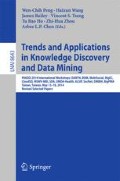Abstract
Effective design and improvement of dynamic feedback in computer-based learning environments requires the ability to assess the effectiveness of a variety of feedback options, not only in terms of overall performance and learning, but also in terms of more subtle effects on students’ learning behavior and understanding. In this paper, we present a novel interestingness measure, and corresponding data mining and visualization approach, which aids the investigation and understanding of students’ learning behaviors. The presented approach identifies sequential patterns of activity that distinguish groups of students (e.g., groups that received different feedback during extended, complex learning activities) by differences in both total behavior pattern usage and evolution of pattern usage over time. We demonstrate the utility of this technique through application to student learning activity data from a recent experiment with the Betty’s Brain learning environment and four different feedback and learning scaffolding conditions.
Access this chapter
Tax calculation will be finalised at checkout
Purchases are for personal use only
Notes
- 1.
In the results presented in Sect. 5, we allowed a maximum gap of one action, allowing up to one irrelevant or variable action between consecutive actions in the pattern. However, in general, other sizes of gaps or no gap at all may be appropriate depending on the data and goals of an analysis.
References
Kinnebrew, J.S., Mack, D.L., Biswas, G.: Mining temporally-interesting learning behavior patterns. In: DMello, S.K., Calvo, R.A., Olney, A. (eds.): Proceedings of the 6th International Conference on Educational Data Mining, pp. 252–255 (2013)
Agrawal, R., Srikant, R.: Mining sequential patterns. In: Proceedings of the Eleventh IEEE International Conference on Data Engineering (ICDE), pp. 3–14 (1995)
Zaki, M.: Sequence mining in categorical domains: incorporating constraints. In: Proceedings of the Ninth International Conference on Information and Knowledge Management, pp. 422–429. ACM (2000)
Nesbit, J., Zhou, M., Xu, Y., Winne, P.: Advancing log analysis of student interactions with cognitive tools. In: 12th Biennial Conference of the European Association for Research on Learning and Insruction (EARLI) (2007)
Perera, D., Kay, J., Koprinska, I., Yacef, K., Zaïane, O.: Clustering and sequential pattern mining of online collaborative learning data. IEEE Trans. Knowl. Data Eng. 21(6), 759–772 (2009)
Kinnebrew, J.S., Loretz, K.M., Biswas, G.: A contextualized, differential sequence mining method to derive students’ learning behavior patterns. J. Educ. Data Min. 5(1), 190–219 (2013)
Kinnebrew, J.S., Biswas, G.: Identifying learning behaviors by contextualizing differential sequence mining with action features and performance evolution. In: Proceedings of the 5th International Conference on Educational Data Mining (EDM 2012), Chania, Greece, June 2012
Amershi, S., Conati, C.: Combining unsupervised and supervised classification to build user models for exploratory learning environments. J. Educ. Data Min. 1(1), 18–71 (2009)
Martinez, R., Yacef, K., Kay, J., Al-Qaraghuli, A., Kharrufa, A.: Analysing frequent sequential patterns of collaborative learning activity around an interactive tabletop. In: Proceedings of the Fourth International Conference on Educational Data Mining, Eindhoven, Netherlands (2011)
Su, J.M., Tseng, S.S., Wang, W., Weng, J.F., Yang, J., Tsai, W.N.: Learning portfolio analysis and mining for scorm compliant environment. J. Educ. Technol. Soc. 9(1), 262–275 (2006)
Geng, L., Hamilton, H.J.: Interestingness measures for data mining: a survey. ACM Comput. Surv. (CSUR) 38(3), 9 (2006)
Zhang, Y., Zhang, L., Nie, G., Shi, Y.: A survey of interestingness measures for association rules. In: International Conference on Business Intelligence and Financial Engineering, BIFE’09, pp. 460–463. IEEE (2009)
Bishop, C.M.: Pattern Recognition and Machine Learning. Springer, New York (2007)
Mitchell, T.: Machine Learning. McGraw Hill, New York (1997)
Merceron, A., Yacef, K.: Interestingness measures for association rules in educational data. In: Educational Data Mining 2008, p. 57 (2008)
Kotsiantis, S., Pierrakeas, C.: Efficiency of machine learning techniques in predicting students performance in distance learning systems. Technical report, Citeseer.
Sotiriou, C., Wirapati, P., Loi, S., Harris, A., Fox, S., Smeds, J., Nordgren, H., Farmer, P., Praz, V., Haibe-Kains, B., et al.: Gene expression profiling in breast cancer: understanding the molecular basis of histologic grade to improve prognosis. J. Natl Cancer Inst. 98(4), 262–272 (2006)
Mashima, D., Kobourov, S., Hu, Y.: Visualizing dynamic data with maps. IEEE Trans. Vis. Comput. Graphics 18(9), 1424–1437 (2012)
Ho, J., Lukov, L., Chawla, S.: Sequential pattern mining with constraints on large protein databases. In: Proceedings of the 12th International Conference on Management of Data (COMAD), pp. 89–100 (2005)
Renyi, A.: On measures of entropy and information. In: Fourth Berkeley Symposium on Mathematical Statistics and Probability, pp. 547–561 (1961)
Biswas, G., Leelawong, K., Schwartz, D., Vye, N., Vanderbilt, T.: Learning by teaching: a new agent paradigm for educational software. Appl. Artif. Intell. 19(3), 363–392 (2005)
Leelawong, K., Biswas, G.: Designing learning by teaching agents: the Betty’s Brain system. Int. J. Artif. Intell. Educ. 18(3), 181–208 (2008)
Acknowledgments
This work has been supported by NSF-IIS Award #0904387 and IES Award #R305A120186.
Author information
Authors and Affiliations
Corresponding author
Editor information
Editors and Affiliations
Rights and permissions
Copyright information
© 2014 Springer International Publishing Switzerland
About this paper
Cite this paper
Kinnebrew, J.S., Mack, D.L.C., Biswas, G., Chang, CK. (2014). A Differential Approach for Identifying Important Student Learning Behavior Patterns with Evolving Usage over Time. In: Peng, WC., et al. Trends and Applications in Knowledge Discovery and Data Mining. PAKDD 2014. Lecture Notes in Computer Science(), vol 8643. Springer, Cham. https://doi.org/10.1007/978-3-319-13186-3_27
Download citation
DOI: https://doi.org/10.1007/978-3-319-13186-3_27
Published:
Publisher Name: Springer, Cham
Print ISBN: 978-3-319-13185-6
Online ISBN: 978-3-319-13186-3
eBook Packages: Computer ScienceComputer Science (R0)

